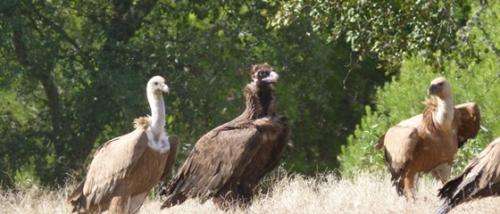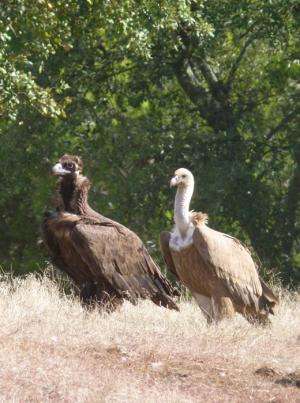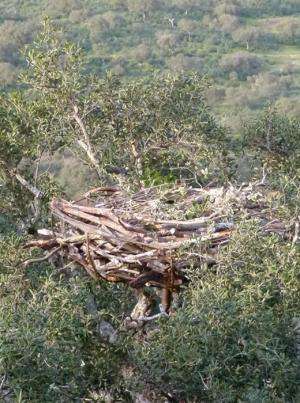After four decades, Eurasian black vultures have finally returned to Portugal's Alentejo region to nest – using artificial platforms constructed by conservationists.
The sighting of two breeding pairs of Eurasian black vultures in southern Portugal has sparked great excitement among conservationists working to improve the fortunes of this much maligned species.
The birds were spotted by staff from Liga para a Protecção da Natureza (LPN), Fauna & Flora International's Portuguese partner, who were monitoring a number of nesting platforms constructed to help these birds re-colonise the region.
The Eurasian black vulture is one of the world's largest birds of prey, with a wingspan that can reach almost three metres across. It is found mainly in forested habitat, and feeds on the carcasses of wild rabbits and domestic livestock.
The vulture's predilection for carrion has done more than foster its shady reputation in folklore, however.
The use of poisoned carcasses as bait for unwanted predators and stray animals has led to the accidental poisoning of these birds, exacerbating other threats such as collision with power lines, declining prey availability, and the loss of suitable habitat and breeding sites.
Combined, these threats led to a sharp decline in the number of black vultures in Portugal, and by the 1970s the country had lost its entire breeding population.
Conservation efforts saw the return of breeding birds to some areas of the country in 2010, but this is the first time in more than 40 years that the black vulture has successfully nested in the south.
Save the vulture, save the lynx
Feeding stations provide food for scavenger birds in a legal, clean and healthy way. Credit: LIFE Habitat Lince Abutre/LPN
Fauna & Flora International (FFI) has been working with LPN since 2003 on a range of activities aimed at conserving the Iberian lynx, which – like the Eurasian black vulture – is now regarded as Critically Endangered in Portugal.
In fact, the lynx and the vulture have much in common besides their status. Both depend heavily on Portugal's cork and holm oak woodlands and have suffered as this 'montado' habitat has deteriorated. They also both face similar threats, including the decline in rabbits – their preferred prey – due to myxomatosis and, later, rabbit haemorrhagic disease.
Supported by the EC's LIFE Programme, LPN and FFI have been working to re-establish a healthy population of Iberian lynx in Portugal by securing suitable habitat, addressing other needs (such as boosting rabbit numbers) and creating habitat corridors that will allow Iberian lynx to cross the border from Spain to Portugal.
Recognising the similarities between the two species, this work has more recently been expanded to include the conservation of the Eurasian black vulture through the construction of feeding and nesting platforms, and public education.
Milestones and setbacks
Vulture nest. Credit: LIFE Habitat Lince Abutre/LPN
The recovery of the black vulture in Portugal is still in its tentative, early stages; however the signs are positive, with around 13 breeding pairs now found in central and northern Portugal.
The arrival of this third colony in the south is a major milestone and shows that conditions have improved to a level that can support a breeding population.
For both the Iberian lynx and the vulture, cooperation with local landowners, land managers and communities has been absolutely instrumental in achieving conservation successes such as this.
But it is not all good news for the vulture.
The introduction of veterinary diclofenac – an anti-inflammatory painkiller used to treat livestock – is a major emerging concern. This drug is fatal to vultures that feed on contaminated carcasses, and is thought to be responsible for the catastrophic decline of vultures in Southeast Asia (over 90% in just 20 years).
While diclofenac has now been banned in some parts of the Indian subcontinent, it is currently available for sale in Spain and Italy. To date, no vulture deaths in Portugal have been traced to the drug, but it is safe to say that the team will be monitoring the situation closely.
Provided by Fauna & Flora International

























